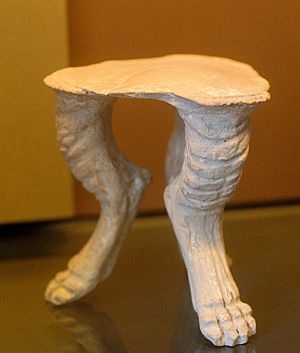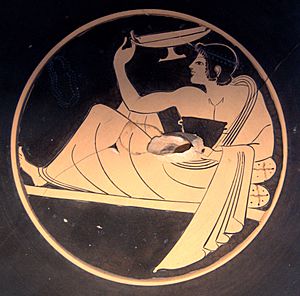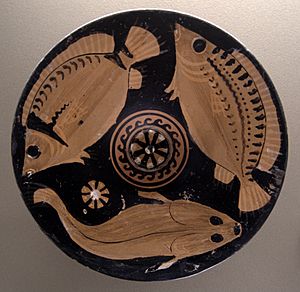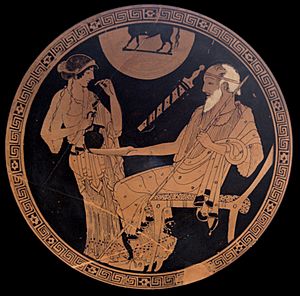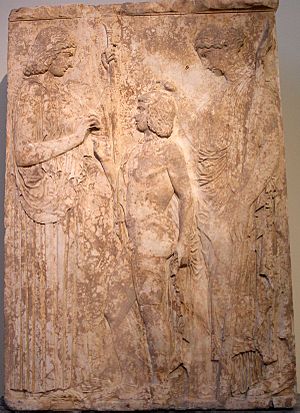Ancient Greek cuisine facts for kids
Ancient Greek food was usually quite simple for most people. This was because farming was hard back then. However, the Greeks knew about many different foods, and rich Greeks loved to have big, fancy meals and parties!
Their food was based on three main things: grains (like wheat and barley), olives, and grapes. These were very important for food and for trade. But other foods were just as vital for everyday meals, especially beans and peas. Experts believe that ancient Greek farming couldn't have worked without growing these legumes.
We know about ancient Greek food and eating habits from old writings, things found by archaeologists, and ancient art.
Contents
Meals in Ancient Greece
The Greeks usually ate three or four meals each day.
Eating at Home
Breakfast
Breakfast was called akratismos. It was often barley bread dipped in wine. Sometimes, people added figs or olives. They also ate a kind of pancake called tagenites.
These pancakes were made from wheat flour, olive oil, honey, and curdled milk. They were a common breakfast food. Another pancake, staitites, was made from spelt flour and topped with honey, sesame, and cheese.
Lunch
A quick lunch was called ariston. It was usually eaten around noon or early afternoon.
Dinner
Dinner (deipnon) was the most important meal. It was usually eaten when the sun went down. Sometimes, people had a light snack in the late afternoon called hesperisma.
How They Ate
Men and women often ate separately. If the house was small, the men ate first, and then the women. This showed respect for the father, who usually earned the family's living. Slaves served the food at dinners. Aristotle noted that poor families, who had no slaves, would have their wives or children serve the meals.
We know a lot about ancient Greek furniture from small clay models found in children's graves. Greeks usually sat on chairs to eat. Benches were used for big parties. Tables were first rectangular, but by the 300s BC, most were round. They often had legs shaped like animal paws, such as lions' paws.
Sometimes, flat bread was used as a plate, but clay bowls were more common. Over time, dishes became fancier. By the Roman period, plates were sometimes made of valuable metals or glass. Forks were not used; people ate with their fingers. Knives were used to cut meat. Spoons were for soups. Pieces of bread could be used to scoop up food or to wipe fingers, like napkins.
Eating with Friends
Just like today, people invited friends or family over for meals. But there were two other special ways of eating together in ancient Greece: the all-male symposium and the mandatory syssitia.
Symposium
A symposium (symposion) was a "banquet". It had two parts. The first part was for eating, and the food was usually simple. The second part was for drinking. However, wine was also drunk with the food, and drinks came with snacks like chestnuts, beans, toasted wheat, or honey cakes.
The second part started with a special drink poured out for the gods, usually Dionysus, the god of wine. After this, people would talk or play table games, like kottabos. Guests would relax on couches, and low tables held the food or game boards.
Dancers, acrobats, and musicians would entertain the rich guests. A "king of the banquet" was chosen by chance. He told the slaves how much water to mix with the wine.
The symposium was only for men. It was a very important part of Greek social life. Only the rich could afford huge feasts. In most Greek homes, religious holidays or family events were celebrated with simpler banquets.
Syssitia
The syssitia (tà syssítia) were required meals shared by groups of men and young people, especially in Crete and Sparta. They were like a type of aristocratic club and a military mess hall. Like the symposium, the syssitia were only for men, though some records mention all-female syssitia. Unlike the symposium, these meals were simple.
Foods and Dishes
"First she set for them a fair and well made table that had feet of cyanus; On it there was a vessel of bronze and an onion to give relish to the drink, with honey and cakes of barley meal." — Homer, Iliad Book XI
Grains
Breads and Cakes
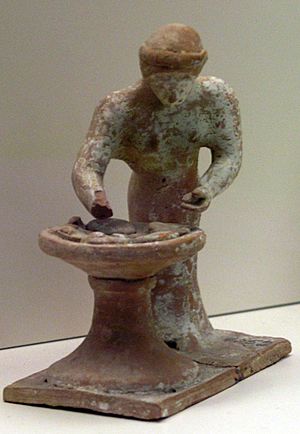
Grains were the most important part of the Greek diet. The two main grains were wheat and barley.
When Greece was taken over by Rome in the 200s BC, commercial bakeries became popular. Pliny the Elder said that making bread moved from homes to "factories" thanks to skilled bakers. Plato preferred homemade bread.
In ancient Greece, bread was served with other foods called opson. This was a general word for anything eaten with bread, like meat, fish, fruit, or vegetables.
Cakes were eaten for religious reasons and for fun. Ancient writers mention melitoutta, which was a honey cake.
Wheat
Wheat grains were soaked to soften them. Then they were ground into flour and made into loaves of bread or flatbreads. These could be plain or mixed with cheese or honey. The Greeks knew how to make bread rise using yeast. They baked bread at home in clay ovens.
White bread made from bread wheat was hard to grow in Greece and was mostly for the rich. Poor people ate rough, brown breads made from emmer wheat and barley.
A simpler way to bake was to heat coals on the floor, then sweep them aside and place the dough on the warm floor. A dome-shaped lid was put over the dough, and coals were piled on top of the lid.
Stone ovens didn't appear until the Roman period. In the 500s BC, Solon, an Athenian lawmaker, said that risen bread should only be for special feast days. By the late 400s BC, risen bread was sold in markets, but it was expensive.
Barley
Barley was easier to grow than wheat, but harder to make into bread. Barley breads were filling but very heavy. So, barley was often roasted before being ground into coarse flour. This flour was used to make maza, a basic Greek dish. Maza could be cooked or raw, like a broth, or made into dumplings or flatbreads. Like wheat breads, it could also be mixed with cheese or honey.
In a play by Aristophanes, the phrase "to eat only barley" meant to live on a very poor diet.
Millet
Millet grew wild in Greece as early as 3000 BCE. Large storage containers for millet have been found from the Late Bronze Age in northern Greece. Hesiod wrote about millet being sown in summer.
Emmer
Black bread, made from emmer, was cheaper and easier to make than wheat bread. It was often eaten by the lower classes and the poor.
Legumes
Legumes (like beans, peas, and lentils) were very important in the Greek diet. They have been harvested in the Mediterranean region since ancient times. Lentils have been found at Greek archaeological sites dating back to the Upper Paleolithic period.
Lentils and chickpeas are the most common legumes mentioned in ancient Greek writings.
- Bitter vetch: This plant was in Greece from at least 8000 BCE. It was sometimes eaten in Classical times, but usually described as animal food with a bad taste.
- Black beans: Homer mentions threshing a black bean in the Iliad.
- Broad beans: Broad, or Fava Beans, are rare in archaeological sites but common in ancient writings. They were eaten as main dishes and in desserts (mixed with figs).
- Chickpeas: Chickpeas are mentioned almost as often as lentils in ancient writings, but are rarely found in Greek archaeological sites.
- Grass peas: Like bitter vetch, grass peas were mainly grown for animal food, but were sometimes eaten during famines.
- Lentils: Theophrastus said that "of the leguminous plants, the lentil is the most prolific."
- Lupin beans: These beans were in the Mediterranean region from prehistoric times. By classical times, Greeks used them for both food and animal feed.
- Garden peas: Peas are commonly found in some of the earliest archaeological sites in Greece, but are rarely mentioned in ancient writings.
Fruit and Vegetables
In ancient Greece, fruit and vegetables were a big part of the diet. The ancient Greeks ate much less meat than people do today. Legumes were important because they helped make the soil healthy again, a fact known by the time of Xenophon.
Hesiod (700s-600s BCE) described many crops eaten by the ancient Greeks, including artichokes and peas.
Vegetables were eaten as soups, boiled, or mashed. They were seasoned with olive oil, vinegar, herbs, or garon, a fish sauce. In plays by Aristophanes, Herakles was shown as a big eater who loved mashed beans. Poor families ate oak acorns. Olives were a common appetizer.
In cities, fresh vegetables were expensive. So, poorer city dwellers often ate dried vegetables. Lentil soup was a typical dish for workers. Cheese, garlic, and onions were common foods for soldiers. In Aristophanes' play Peace, the smell of onions often meant soldiers. The chorus, celebrating the end of war, sings, "Oh! joy, joy! No more helmet, no more cheese nor onions!"
Fruits, fresh or dried, and nuts were eaten as dessert. Important fruits were figs, raisins, and pomegranates. Dried figs were also eaten as an appetizer or with wine. When drinking wine, they were often served with grilled chestnuts, chickpeas, and beechnuts.
Animals
Meat
In the 700s BC, Hesiod described an ideal country feast: "the flesh of a heifer fed in the woods, that has never calved, and of firstling kids."
Meat is mentioned less in texts from the 400s BC onwards, but this might be because of the type of writing, not a real change in food habits. Fresh meat was most often eaten during sacrifices. However, sausage was very common and eaten by people of all wealth levels. Besides animal meat, ancient Greeks often ate inner organs, like paunches and tripe, which were considered special treats.
The Spartans mainly ate a soup made from pigs' legs and blood, called melas zōmos (black soup). According to Plutarch, it was so valued that older men ate only it, leaving the meat for younger men. It was famous among the Greeks. It was made with pork, salt, vinegar, and blood. The dish was served with maza, figs, and cheese, sometimes with game and fish.
How much fish and meat people ate depended on how rich they were and where they lived. In the countryside, hunting (mostly trapping) provided birds and hares. Farmers also had chickens and geese. Slightly richer landowners could raise goats, pigs, or sheep. In the city, meat was expensive, except for pork. Sausages were common for both poor and rich people.
Archaeological digs show that dogs were sometimes eaten in Bronze Age Greece, along with pigs, cattle, sheep, and goats.
Fish
In the Greek islands and on the coast, fresh fish and seafood (like squid, octopus, and shellfish) were common. They were eaten locally but often sent inland. Sardines and anchovies were regular food for people in Athens. They were sometimes sold fresh, but more often salted. A stone tablet from the late 200s BC lists fish prices. The cheapest was skaren (probably parrotfish), while Atlantic bluefin tuna was three times more expensive. Common saltwater fish included yellowfin tuna, red mullet, ray, swordfish, or sturgeon. Lake Copais was famous for its eels. Other freshwater fish were pike-fish, carp, and catfish.
Fowl
Ancient Greeks ate many more kinds of birds than people do today. Pheasants were present as early as 2000 BCE. Domestic chickens came to Greece from Asia Minor around 600 BCE, and domesticated geese are mentioned in The Odyssey (800 BCE). Quail, moorhen, capon, mallards, pheasants, larks, pigeons and doves were all raised in classical times and even sold in markets. Many other wild birds were hunted or trapped and eaten.
Eggs and Dairy Products
Eggs
Greeks raised quails and hens, partly for their eggs. Some writers also praised pheasant eggs and Egyptian goose eggs, which were probably rare. Eggs were cooked soft- or hard-boiled as appetizers or desserts. Whites, yolks, and whole eggs were also used in cooking.
Milk
Hesiod describes "milk cake, and milk of goats drained dry." People in the countryside drank milk (gala), but it was rarely used in cooking.
Butter
Butter was known but rarely used. Greeks saw it as a food of the Thracians from the northern Aegean coast.
Cheese and Yogurt
Cheesemaking was common by the 700s BCE.
Greeks enjoyed other dairy products. Pyriatē and Oxygala were curdled milk products, like cottage cheese or yogurt. Most of all, goat's and ewe's cheese (tyros) was a basic food. Fresh cheeses and hard cheeses were sold in different shops.
Cheese was eaten alone or with honey or vegetables. It was also used in many dishes, including fish dishes. However, adding cheese to fish was sometimes debated.
Spices and Seasonings
The first spice mentioned in ancient Greek writings is cassia, mentioned by Sappho in the 600s-500s BCE. The ancient Greeks knew the difference between Ceylon cinnamon and cassia.
Ancient Greeks used at least two kinds of pepper: black pepper and long pepper. Theophrastus listed several "pot herbs" including dill, coriander, anise, cumin, fennel, rue, and celery.
Recipes
Homer describes making a wine and cheese drink: "taking Pramnian wine she grated goat's milk cheese into it with a bronze grater [and] threw in a handful of white barley meal." (Book 11 of the Iliad)
Only one piece of the first known cookbook from any culture still exists. It was written by Mithaecus in the 400s BCE and is quoted in another book. It's a recipe for a fish called "tainia": "Tainia": gut, discard the head, rinse, slice; add cheese and [olive] oil.
Archestratus (300s BCE), who called himself the "inventor of made dishes," described a recipe for paunch and tripe, cooked in "cumin juice, and vinegar and sharp, strong-smelling silphium".
Drinks
The most common drink was water. Getting water was a daily job for women. While wells were common, spring water was preferred. It was seen as healthy because it helped plants grow, and it was a pleasant drink. Pindar called spring water "as agreeable as honey."
Greeks described water in many ways, like strong, heavy, light, dry, or wine-like. One writer said he could tell Athenian water just by its taste. Some philosophers were known for drinking only water and eating a vegetarian diet. Milk, usually goat's milk, was not widely drunk; it was seen as a drink for "barbarians."
The usual drinking cup was the skyphos, made of wood, clay, or metal. The kothon was a Spartan cup that could hide the color of the water and trap mud. For banquets, they used a kylix (a shallow bowl) or a kantharos (a deep cup with handles), or a rhyton, which was a drinking horn shaped like a human or animal head.
Wine
The Greeks are thought to have made red, rosé, and white wines. Like today, these wines varied in quality from everyday table wine to expensive old wines. The best wines were generally thought to come from Thásos, Lesbos, and Chios.
Cretan wine became famous later. A simpler wine, made from water and the leftover grape pulp after squeezing, was made by country people for their own use. The Greeks sometimes sweetened their wine with honey and made medicinal wines by adding thyme and other herbs. By the 1st century, they knew about wine flavored with pine resin (like modern retsina).
Wine was usually mixed with water. Drinking akraton, or "unmixed wine," was seen as something only northern barbarians did and was thought to lead to madness and death. Wine was mixed in a krater, and then slaves would fill the drinker's cup with a jug.
Greek society generally did not approve of women drinking wine. Sparta was the only city where women regularly drank wine.
Wine for local use was kept in animal skins. Wine for sale was poured into large clay jugs called pithoi. From there, it was put into amphoras sealed with pitch for selling. Old wines had stamps from the producers or city officials who guaranteed where they came from. This was one of the first times people marked where a product came from or how good it was.
Kykeon
The Greeks also drank kykeon, which was both a drink and a meal. It was a barley gruel with water and herbs added. In the Iliad, it also had grated goat cheese. In the Odyssey, Circe adds honey and a magic potion to it.
Kykeon was used as a ritual drink in the Eleusinian Mysteries, but it was also a popular drink, especially in the countryside. It was also thought to help with digestion.
Ancient Writers on Food
Many ancient writers wrote about food and cooking. Timachidas wrote 11 books of dinner recipes. Other authors like Noumenios, Matreas, Hegemon, Artemidoros, and Philoxenos also wrote cookbooks.
Some flat-cakes were even named after Philoxenos, called Philoxenean cakes.
Cultural Ideas About Food
Food was very important in how Greeks thought about the world. One expert, John Wilkins, notes that in The Odyssey, good people are different from bad people, and Greeks from foreigners, partly by what and how they ate.
Until the 200s BC, being simple with food was seen as a good thing, because of the hard farming conditions. Greeks enjoyed eating, but they valued simplicity. The writer Hesiod spoke of "the flesh of a heifer fed in the woods... and of firstling kids" as the perfect end to a day.
Fancy cooking was seen as a sign of being weak, like the people of the Persian Empire. Greek writers enjoyed describing the luxurious meals of the Persian King and his court, seeing them as a sign of their decadence.
In contrast, Greeks often emphasized how simple their own diet was. Plutarch tells a story about the king of Pontus who wanted to try the Spartan "black gruel." He bought a Spartan cook, but when he tasted it, he found it terrible. The cook told him, "Sir, to make this broth taste good, you should have bathed yourself first in the river Eurotas." This meant you needed to be as tough as a Spartan to enjoy it.
Because of this focus on simple food, cooking was long seen as a job for women, whether free or enslaved. However, in the classical period, professional cooks started to appear in writings.
Over time, more and more Greeks became interested in fine food. From the Hellenistic to the Roman period, rich Greeks were no longer more simple than others. Guests at a feast described by Athenaeus in the 2nd or 3rd century spent much of their time talking about wine and fancy food. They discussed different wines, vegetables, and meats, mentioning famous dishes and great cooks.
Special Diets
Vegetarianism
Orphism and Pythagoreanism, two ancient Greek religions, suggested a different way of life based on purity. Vegetarianism was a main part of these beliefs.
Empedocles (400s BC) believed in vegetarianism because he thought souls could be reborn into animals. So, he wondered who could guarantee that an animal about to be killed didn't have a human soul. However, he also believed plants had souls, so this logic could apply to eating them too. Vegetarianism also came from a dislike of killing.
It's harder to know exactly what Pythagoras (500s BC) believed. Writers like Aristophanes described Pythagoreans as strict vegetarians, with some living only on bread and water. Other traditions only banned certain vegetables, like broad beans, or sacred animals.
This shows that vegetarianism and the idea of purity were closely linked. Plutarch (1st–2nd century) wrote about how barbaric it was to shed blood, asking meat-eaters to explain their choice.
Athlete Diets
Aelian claimed that the first athlete to follow a special diet was Ikkos of Tarentum, an Olympic winner. However, the Olympic wrestling champion Milo of Croton was already said to eat twenty pounds of meat and twenty pounds of bread and drink eight quarts of wine every day! Before his time, athletes were said to eat xerophagia, a diet of dry foods like dried figs, fresh cheese, and bread. Pythagoras (either the philosopher or a gymnastics teacher) was the first to tell athletes to eat meat.
Later, trainers set strict diet rules: to win at the Olympics, "you have to eat according to regulations, stay away from desserts (...); you must not drink cold water nor can you have a drink of wine whenever you want." This diet seemed to be mostly meat-based.
See also
 In Spanish: Alimentación en la Antigua Grecia para niños
In Spanish: Alimentación en la Antigua Grecia para niños


